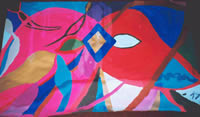Description
The Expressive Arts Therapist must have an understanding of creative arts modalities, the creative process, and the idea of multi-modal theories in order to develop a skilled flair for weaving the arts into a healing tapestry. By first introducing the individual creative arts modalities, this course focuses on introducing the Expressive Arts approaches, paradigms, and theoretical concepts that aid in developing multi-modal fluency. Through personal process, discussion, and readings, Expressive Arts approaches will be demonstrated, compared, and contrasted. Additional readings and class presentations will address the key issues cited above.
The experienced EXA therapist must become familiar with the rich world of EXA approaches, theories, and multi-modal paradigms for the weaving of creative arts modalities into a healing process for their clients. In addition, familiarity with the creative process and its links with the therapeutic process and spiritual emergence must be a part of an EXA therapist’s repertoire. With this grounding, the new therapist can then develop her own EXA approaches that will address the issues and needs of her clients, cross-culturally with individuals and groups.
Learning Objectives
Participants will:
- Experience various Expressive Arts approaches.
- Develop a theoretical understanding of these various approaches.
- Begin to understand the ways to weave arts modalities.
- Be introduced to paradigms that will aid in comparing and contrasting modalities.
- Understand EXA applications to diverse cultural groups and individuals.
- Understand EXA applications to various levels of wounding and potentials.








